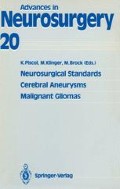Abstract
Using a comprehensive statistical analysis, Kassell and Drake [9] were able to illustrate the fatal consequences of aneurysmal rupture. Many authors have advocated an early operation to reduce both the rebleeding and vasospasm rates [2, 4, 11–13, 21]. Nevertheless, the results of early operations have been varied and, in their interpretation, are not uncontroversial. Discussion centered mainly on the range of criteria for an early operation in terms of aneurysm site and grade at the time of admission [1, 5, 7, 9, 10, 15, 20]. A comparison of the various treatment strategies reveals methodological problems due to differences in selection when the patients are allocated to the clinics and due to the choice of outcome parameters [13, 16]. Generally recognized as comparison values are the definitions of management mortality and management morbidity, which were coined by Lougheed [14]. In this paper, we present the management results of a series of predominantly delayed operations on ruptured aneurysms.
Access this chapter
Tax calculation will be finalised at checkout
Purchases are for personal use only
Preview
Unable to display preview. Download preview PDF.
References
Adams HP (1986) Early management of the patient with recent aneurysmal subarachnoid hemorrhage. Stroke 17:1068–1070
Auer LM (1983) Acute surgery of cerebral aneurysms and prevention of symptomatic vasospasm. Acta Neurochir (Wien) 69:273–281
Auer LM, Brandt L, Ebeling U, Gilsbach J, Groeger U, Harders A, Ljunggren B, Oppel F, Reulen HJ, Saeveland H (1986) Nimodipine and early aneurysm operation in good condition SAH patients. Acta Neurochir 82:7–13
Ausman JI, Diaz FG, Malik GM, Fielding AS, Son CS (1985) Current management of cerebral aneurysms: Is it based on facts or myths? Surg Neurol 24:625–635
Chyatte D, Fode NC, Sundt TM (1988) Early versus late intracranial aneurysm surgery in subarachnoid hemorrhage. J Neurosurg 69:326–331
Disney L, Weir B, Petruk K (1987) Effect on management mortality of deliberate policy of early operation on supratentorial aneurysms. Neurosurgery 20:695–701
Flamm ES (1986) The timing of aneurysm surgery 1985. Clin Neurosurg 33:147–158
Gilsbach JM, Harders AG (1989) Morbidity and mortality after early aneurysm surgery — a prospective study with nimodipine prevention. Acta Neurochir 96:1–7
Kassell NF, Drake CG (1982) Timing of aneurysm surgery. Neurosurgery 10:514–519
Kassell NF, Kongable GL, Torner JC, Adams HP, Mazuz H (1985) Delay in referral of patients with ruptured aneurysms to neurosurgical attention. Stroke 16:587–590
Ljunggren B, Brandt L, Kagström E, Sundbärg G (1981) Results of early operations for ruptured aneurysms. J Neurosurg 54:473–479
Ljunggren B, Brandt L, Säveland H, Nilson PE, Cronqvist S, Andersson KE, Vinge E (1984) Outcome in 60 consecutive patients treated with early aneurysm operation and intravenous nimodipine. J Neurosurg 61:864–873
Ljunggren B, Säveland H, Brandt L, Zygmunt S (1985) Early operation and overall outcome in aneurysmal subarachnoid hemorrhage. J Neurosurg 62:547–551
Lougheed WM (1969) Selection, timing, and technique of aneurysm surgery of the anterior circle of Willis. Clin Neurosurg 16:95–113
Marsh H, Maurice-Williams RS, Lindsay KW (1987) Differences in the management of ruptured intracranial aneurysms: a survey of practice amongst British neurosurgeons. J Neurol Neurosurg Psychiatry 50:965–970
Maurice-Williams RS, Marsh H (1985) Ruptured intracranial aneurysms: the overall effect of treatment and the influence of patient selection and data presentation on the reported outcome. J Neurol Neurosurg Psychiatry 48:1208–1212
Milhorat TH, Krautheim M (1985) Results of early and delayed operation for ruptured intracranial aneurysms in two series of 100 consecutive patients. Surg Neurol 26:123–128
Öhman J, Heiskanen O (1988) Effect of nimodipine on the outcome of patients after aneurysmal subarachnoidal hemorrhage and surgery. J Neurosurg 69:683–686
Ropper AH, Zervas NT (1984) Outcome 1 year after SAH from cerebral aneurysm. Management morbidity, mortality, and functional status in 112 consecutive good-risk patients. J Neurosurg 60:909–915
Säveland H, Ljunggren B, Brandt L, Messeter K (1986) Delayed ischemic deterioration in patients with early aneurysm operation and intravenous nimodipine. Neurosurgery 18:146–150
Sakaki S, Onta S, Kuwabara H, Shiraishi M (1987) The role of ventricular and cisternal drainage in the early operation for ruptured intracranial aneurysms. Acta Neurochir 88:87–94
Seiler RW, Reulen HJ, Huber P, Grolimund P, Ebeling U, Steiger HJ (1988) Outcome of aneurysmal subarachnoid hemorrhage in a hospital population: a prospective study including early operation, intravenous nimodipine, and transcranial Doppler ultrasound. Neurosurgery 23:598–604
Taneda M (1982) The significance of early operation in the management of ruptured intracranial aneurysms — an analysis of 251 cases hospitalized within 24 hours after subarachnoid haemorrhage. Acta Neurochir (Wien) 63:201–208
Author information
Authors and Affiliations
Editor information
Editors and Affiliations
Rights and permissions
Copyright information
© 1992 Springer-Verlag Berlin Heidelberg
About this paper
Cite this paper
Krupp, W., Heienbrok, W., Müke, R. (1992). Management Results of a Series of Predominantly Delayed Operations on Ruptured Aneurysms. In: Piscol, K., Klinger, M., Brock, M. (eds) Neurosurgical Standards Cerebral Aneurysms Malignant Gliomas. Advances in Neurosurgery, vol 20. Springer, Berlin, Heidelberg. https://doi.org/10.1007/978-3-642-77109-5_21
Download citation
DOI: https://doi.org/10.1007/978-3-642-77109-5_21
Publisher Name: Springer, Berlin, Heidelberg
Print ISBN: 978-3-540-54838-6
Online ISBN: 978-3-642-77109-5
eBook Packages: Springer Book Archive

